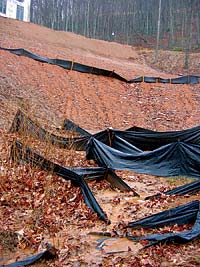When the city of Asheville solicited public comment on upcoming revisions to its storm-water and erosion-control ordinances, there was no shortage of community members eager to weigh in.

A Nov. 28 public meeting in the Public Works Building drew a large crowd, suggesting that a proposed clampdown on construction-related runoff remains a touchy issue. Under the federal Clean Water Act, the city had to update its ordinance in order to obtain a newly required federal storm-water permit by this past July. City Council approved stricter storm-water rules in August, bringing Asheville into compliance with the federal guidelines. But Council asked the Watershed Policy Committee to revisit certain sticking points in the ordinance and submit proposed changes at a later date. The 37-member committee is seeking public input on those changes, with a second meeting planned for an as-yet-unspecified date.
Among the more contentious items are aquatic-buffer zones meant to protect waterways from storm-water and sediment runoff. The new rules would place restrictions on development and redevelopment within buffer zones. In August, City Council expanded the width of required buffers to 30 feet—the statewide minimum. But a second buffer requirement, which would add a filtration zone to protect waterways, is still under consideration. “It’s been shown that an additional 20-foot buffer has an important removal effect,” environmental consultant Marshall Taylor explained during the meeting. Recommended by the state, the additional buffer has been adopted by municipalities across North Carolina, he said.
Some audience members, however, said that implementing any sort of buffer amounts to taking private property. During a brief question-and-answer session, one community member asked whether landowners would be compensated for what he called a form of eminent domain. City staff responded that both the current and proposed rules, which deal only with development and redevelopment, aren’t considered eminent domain. Existing structures would be grandfathered, and landowners could also apply for a variance in certain situations.
The Watershed Policy Committee, consisting mostly of volunteers, is expected to make recommendations to Council sometime in the next several months. Committee members represent a wide variety of interests: Three work for Biltmore Farms, a major real-estate-development firm, and a number of others are associated with the Asheville Area Chamber of Commerce, the Council of Independent Business Owners and various construction and architectural firms. Other committee members include Karen Cragnolin and Hartwell Carson of RiverLink, and Skip Metheny, who joined the committee after watching a mudflow from a nearby construction project tear through his back yard. “There is probably about 20 tons of dirt on my property that wasn’t there before,” he said.
“Nobody on the committee is not in favor of high standards,” noted Biltmore Farms employee Paul Szurek. When it comes to buffers, however, the question is how to balance environmental pluses—such as better storm-water filtration—with restrictions on private-property rights, he added.
But committee member James Rogers, whose graduate work at the University of Georgia has given him expertise in hydrology and sedimentation, says he doesn’t think the debate needs to framed in terms of property rights vs. the environment. “People seem to think this is a spotted-owl issue,” he said, referring to a heated controversy in the 1980s and ‘90s that resulted in restrictions on the timber industry to protect the threatened species. But as Rogers sees it, flooding should be a key part of the discussion. “If you change a watershed, you’ll have more floods and bigger floods,” he notes. “If flooding increases, property value will decrease. It becomes very problematic.” Related issues such as insurance, flood-protection measures and drought should figure into any decision regarding buffer rules, says Rogers, and protecting small streams should be a priority.
As the meeting was getting under way, facilitators asked for a show of hands as to how people had heard about the meeting. The vast majority, it appeared, were there because they’d received a letter from the Watershed Policy Committee. Letters were sent to property owners who would be affected by the new rules if they sought to develop or redevelop their property. Public input will be factored into the final decision.



Before you comment
The comments section is here to provide a platform for civil dialogue on the issues we face together as a local community. Xpress is committed to offering this platform for all voices, but when the tone of the discussion gets nasty or strays off topic, we believe many people choose not to participate. Xpress editors are determined to moderate comments to ensure a constructive interchange is maintained. All comments judged not to be in keeping with the spirit of civil discourse will be removed and repeat violators will be banned. See here for our terms of service. Thank you for being part of this effort to promote respectful discussion.